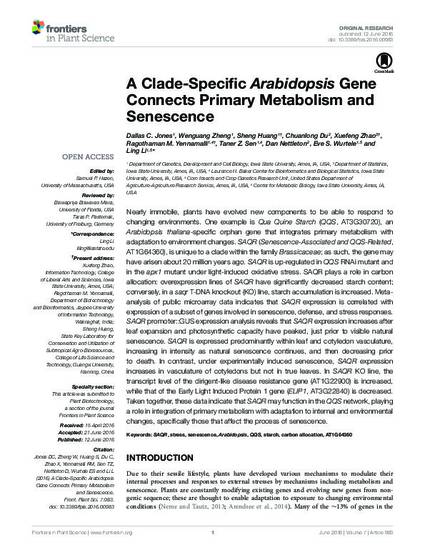
Nearly immobile, plants have evolved new components to be able to respond to changing environments. One example is Qua Quine Starch (QQS, AT3G30720), an Arabidopsis thaliana-specific orphan gene that integrates primary metabolism with adaptation to environment changes. SAQR (Senescence-Associated and QQS-Related, AT1G64360), is unique to a clade within the family Brassicaceae; as such, the gene may have arisen about 20 million years ago. SAQR is up-regulated in QQS RNAi mutant and in the apx1 mutant under light-induced oxidative stress. SAQR plays a role in carbon allocation: overexpression lines of SAQR have significantly decreased starch content; conversely, in a saqr T-DNA knockout (KO) line, starch accumulation is increased. Meta-analysis of public microarray data indicates that SAQR expression is correlated with expression of a subset of genes involved in senescence, defense, and stress responses. SAQR promoter::GUS expression analysis reveals that SAQR expression increases after leaf expansion and photosynthetic capacity have peaked, just prior to visible natural senescence. SAQR is expressed predominantly within leaf and cotyledon vasculature, increasing in intensity as natural senescence continues, and then decreasing prior to death. In contrast, under experimentally induced senescence, SAQR expression increases in vasculature of cotyledons but not in true leaves. In SAQR KO line, the transcript level of the dirigent-like disease resistance gene (AT1G22900) is increased, while that of the Early Light Induced Protein 1 gene (ELIP1, AT3G22840) is decreased. Taken together, these data indicate that SAQR may function in the QQS network, playing a role in integration of primary metabolism with adaptation to internal and environmental changes, specifically those that affect the process of senescence.
Available at: http://works.bepress.com/dan-nettleton/1/

This article is from Frontiers in Plant Science 7 (2016): 983, doi: 10.3389/fpls.2016.00983.